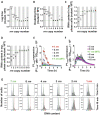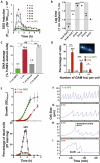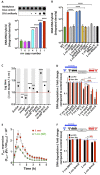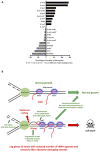rRNA operon multiplicity as a bacterial genome stability insurance policy
- PMID: 35552441
- PMCID: PMC9825170
- DOI: 10.1093/nar/gkac332
rRNA operon multiplicity as a bacterial genome stability insurance policy
Abstract
Quick growth restart after upon encountering favourable environmental conditions is a major fitness contributor in natural environment. It is widely assumed that the time required to restart growth after nutritional upshift is determined by how long it takes for cells to synthesize enough ribosomes to produce the proteins required to reinitiate growth. Here we show that a reduction in the capacity to synthesize ribosomes by reducing number of ribosomal RNA (rRNA) operons (rrn) causes a longer transition from stationary phase to growth of Escherichia coli primarily due to high mortality rates. Cell death results from DNA replication blockage and massive DNA breakage at the sites of the remaining rrn operons that become overloaded with RNA polymerases (RNAPs). Mortality rates and growth restart duration can be reduced by preventing R-loop formation and improving DNA repair capacity. The same molecular mechanisms determine the duration of the recovery phase after ribosome-damaging stresses, such as antibiotics, exposure to bile salts or high temperature. Our study therefore suggests that a major function of rrn operon multiplicity is to ensure that individual rrn operons are not saturated by RNAPs, which can result in catastrophic chromosome replication failure and cell death during adaptation to environmental fluctuations.
Plain language summary
The ability to modulate translation capacity, which resides greatly on a number of ribosomes, provides robustness in fluctuating environments. Because translation is energetically the most expensive process in cells, cells must constantly adapt the rate of ribosome production to resource availability. This is primarily achieved by regulating ribosomal RNA (rRNA) synthesis, to which ribosomal proteins synthesis is adjusted. The multiplicity of rRNA encoding operons per bacterial genome exceeds requirements for the maximal growth rates in non-stress conditions. In this study, the authors provide evidence that a major function of rRNA operon multiplicity is to ensure that individual operons are not saturated by RNA polymerases during adaptation to environmental fluctuations, which can result in catastrophic chromosome replication failure and cell death.
© The Author(s) 2022. Published by Oxford University Press on behalf of Nucleic Acids Research.
Figures







Similar articles
-
RNA polymerase redistribution supports growth in E. coli strains with a minimal number of rRNA operons.Nucleic Acids Res. 2023 Aug 25;51(15):8085-8101. doi: 10.1093/nar/gkad511. Nucleic Acids Res. 2023. PMID: 37351576 Free PMC article.
-
Strategies used by pathogenic and nonpathogenic mycobacteria to synthesize rRNA.J Bacteriol. 1997 Nov;179(22):6949-58. doi: 10.1128/jb.179.22.6949-6958.1997. J Bacteriol. 1997. PMID: 9371439 Free PMC article.
-
rRNA operon multiplicity in Escherichia coli and the physiological implications of rrn inactivation.J Bacteriol. 1995 Jul;177(14):4152-6. doi: 10.1128/jb.177.14.4152-4156.1995. J Bacteriol. 1995. PMID: 7608093 Free PMC article.
-
Engineering of bacterial ribosomes: replacement of all seven Escherichia coli rRNA operons by a single plasmid-encoded operon.Proc Natl Acad Sci U S A. 1999 Mar 2;96(5):1820-2. doi: 10.1073/pnas.96.5.1820. Proc Natl Acad Sci U S A. 1999. PMID: 10051551 Free PMC article. Review. No abstract available.
-
Control of rRNA synthesis in Escherichia coli: a systems biology approach.Microbiol Mol Biol Rev. 2004 Dec;68(4):639-68. doi: 10.1128/MMBR.68.4.639-668.2004. Microbiol Mol Biol Rev. 2004. PMID: 15590778 Free PMC article. Review.
Cited by
-
Ribosomal RNA operons define a central functional compartment in the Streptomyces chromosome.Nucleic Acids Res. 2022 Nov 11;50(20):11654-11669. doi: 10.1093/nar/gkac1076. Nucleic Acids Res. 2022. PMID: 36408918 Free PMC article.
-
Ribosomal Intergenic Spacers Are Filled with Transposon Remnants.Genome Biol Evol. 2023 Jul 3;15(7):evad114. doi: 10.1093/gbe/evad114. Genome Biol Evol. 2023. PMID: 37341531 Free PMC article.
-
Recycling of Bacterial RNA Polymerase by the Swi2/Snf2 ATPase RapA.bioRxiv [Preprint]. 2023 Mar 24:2023.03.22.533849. doi: 10.1101/2023.03.22.533849. bioRxiv. 2023. Update in: Proc Natl Acad Sci U S A. 2023 Jul 11;120(28):e2303849120. doi: 10.1073/pnas.2303849120. PMID: 36993374 Free PMC article. Updated. Preprint.
-
RNA polymerase redistribution supports growth in E. coli strains with a minimal number of rRNA operons.Nucleic Acids Res. 2023 Aug 25;51(15):8085-8101. doi: 10.1093/nar/gkad511. Nucleic Acids Res. 2023. PMID: 37351576 Free PMC article.
-
ResR/McdR-regulated protein translation machinery contributes to drug resilience in Mycobacterium tuberculosis.Commun Biol. 2023 Jul 11;6(1):708. doi: 10.1038/s42003-023-05059-8. Commun Biol. 2023. PMID: 37433855 Free PMC article.
References
Publication types
MeSH terms
Substances
LinkOut - more resources
Full Text Sources
Other Literature Sources
Molecular Biology Databases

